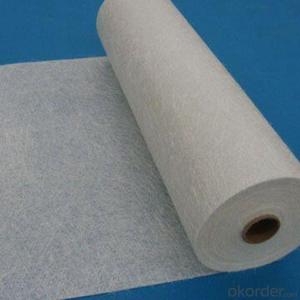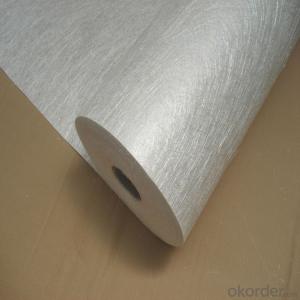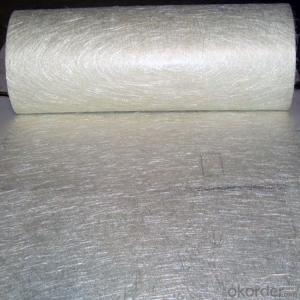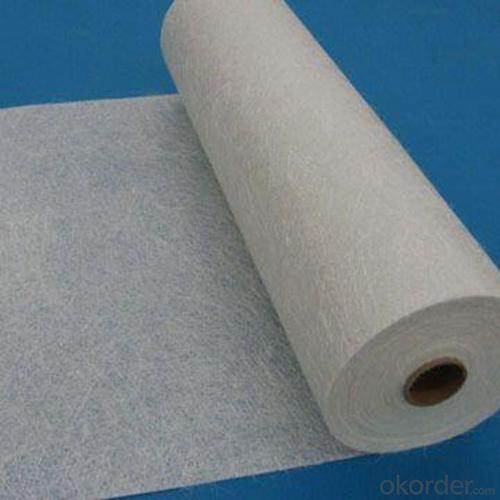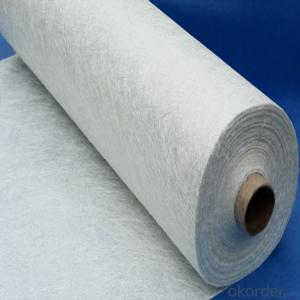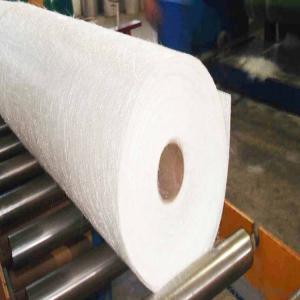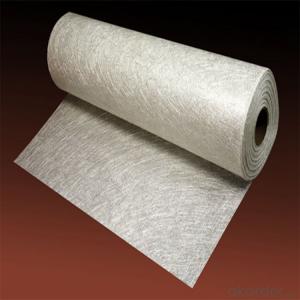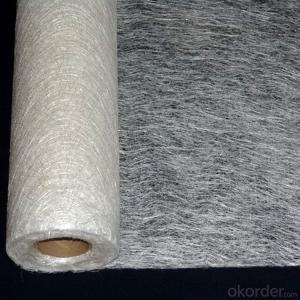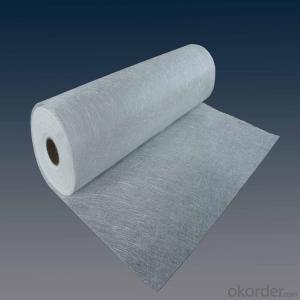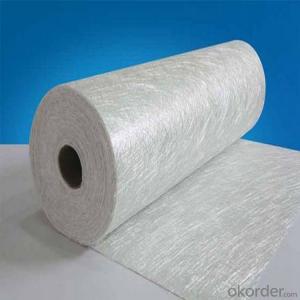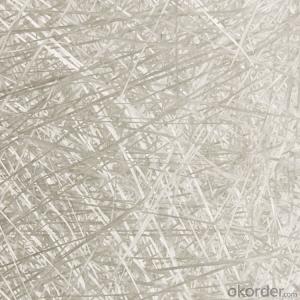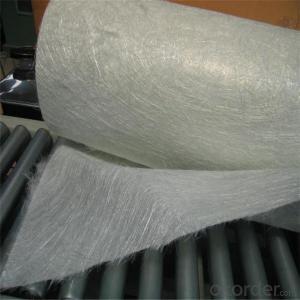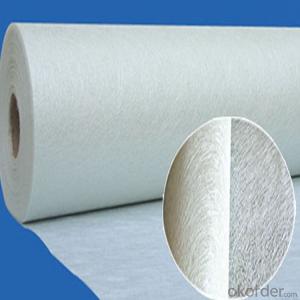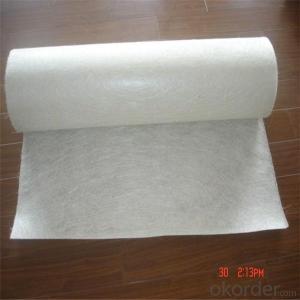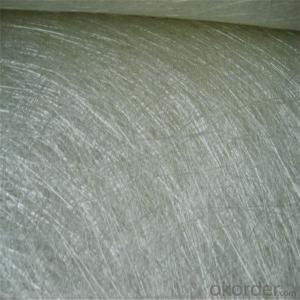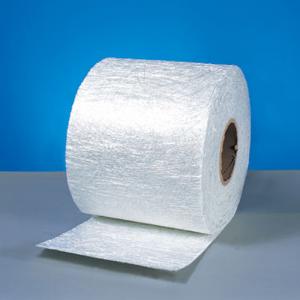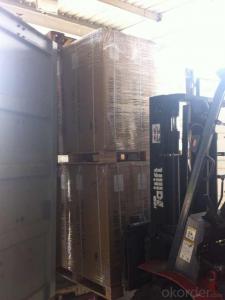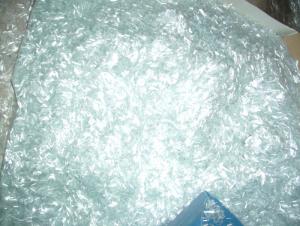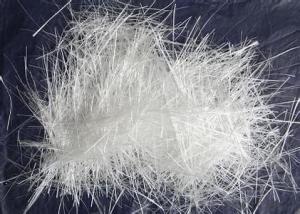Chop Strand Mat Fiberglass - E-Glass or C-Glass Fiber Reinforced Plastics
- Loading Port:
- China main port
- Payment Terms:
- TT OR LC
- Min Order Qty:
- 1 kg
- Supply Capability:
- 5000 kg/month
OKorder Service Pledge
OKorder Financial Service
You Might Also Like
Product Description:

Surfacing Tissue mainly used in the surface layers of FRP products. It features even Fiber distribution, soft feel, level and smooth fiber surface, less glue content, quick resin soak and good pattern fitness. It can improve the product surface property on corrosion resistance, compressive strength, seepage resistance, and longer service life. It is also suitable for spraying; pattern pressing and other FRP pattern technology.
Surfacing Tissue mainly used in the surface layers of FRP products. It features even Fiber distribution, soft feel, level and smooth fiber surface, less glue content, quick resin soak and good pattern fitness. It can improve the product surface property on corrosion resistance, compressive strength, seepage resistance, and longer service life. It is also suitable for spraying; pattern pressing and other FRP pattern technology.
Product Features:
Fast breakdown in styrene
Fiber dispersed evenly
Low binder content
Superior acid corrosion resistance
Specifications:
Item | Over Density | Moisture Content | Chop Density | Polyester Yarn | Width |
(g/m2) | (%) | (g/m2) | (g/m2) | (mm) | |
EMK300 | 309.5 | ≤0.15 | 300 | 9.5 | 50-3300 |
EMK380 | 399 | 380 | 19 | ||
EMK450 | 459.5 | 450 | 9.5 | ||
EMK450 | 469 | 450 | 19 | ||
EMC0020 | 620.9 | 601.9 | 19 | ||
EMC0030 | 909.5 | 900 | 9.5 |
Product Packaging:
Each Surface Tissue is wound onto a paper tube which has an inside diameter of 76mm and the mat roll has a diameter of 330mm. The mat roll is wrapped up with plastic film,and then packed in a cardboard box or wrapped up with kraft paper. The rolls can be vertically or horizontally placed. For transportation, the rolls can be loaded into a cantainer directly or on pallets.
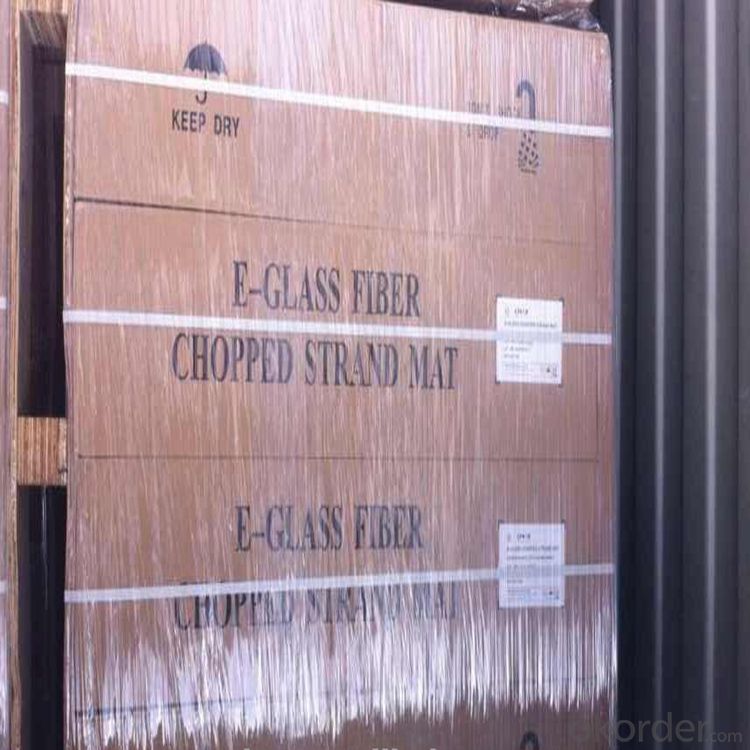
Product Storage:
Unless otherwise specified, Chopped Strand Mat should be stored in a dry, cool and rain-proof area. It is recommended that the room temperature and humidity should be always maintained at 15℃~35℃ and 50%~75% respectively.
Company Information
CNBM (China National Building Material) Group is the largest comprehensive building materials group in China that in integrate scientific research, manufacturing and logistics into one entity. The largest building materials and equipment specialists in China. Upon State Council approval, today CNBM owned more than 300 subordinate manufacturing factories and servicing companies. There are 6 fully owned public listed companies and 11 partially owned with substantial shares public listed companies. In many of these fields, CNBM is playing the leading role in the building industry in the country.

- Q: Can fiberglass chopped strand be used for reinforcing metal matrix composites?
- Reinforcing metal matrix composites is possible using fiberglass chopped strand. This material consists of small glass fibers that are randomly oriented and held together with a binder. By adding these fibers to a metal matrix, the mechanical properties of the composite, such as strength and stiffness, can be enhanced. The utilization of fiberglass chopped strand as reinforcement in metal matrix composites presents several advantages. Firstly, fiberglass is a lightweight substance, which aids in reducing the overall weight of the composite without compromising its strength. This is particularly advantageous in industries where weight reduction is critical, like aerospace and automotive. Secondly, fiberglass chopped strand possesses a high tensile strength, enabling it to effectively distribute and transfer stress within the composite. As a result, the composite's resistance to deformation is improved, and its load-bearing capacity is enhanced. Lastly, fiberglass chopped strand offers excellent corrosion resistance, making it suitable for applications where the composite is exposed to harsh environments or chemical substances. Nevertheless, it is crucial to consider the compatibility between the fiberglass chopped strand and the metal matrix. The metal matrix must have good wetting and adhesion properties to ensure a strong bond with the fiberglass fibers. Additionally, the composite fabrication process should be carefully optimized to achieve uniform dispersion and alignment of the fibers within the metal matrix. In conclusion, fiberglass chopped strand is a suitable option for reinforcing metal matrix composites. It brings forth improved mechanical properties, weight reduction, and corrosion resistance.
- Q: How is the surface treatment of fiberglass chopped strand done?
- The surface treatment of fiberglass chopped strand is typically done through a process called sizing. Sizing involves applying a chemical coating to the strands to improve their adhesion to resins or other materials during manufacturing. This treatment helps enhance the overall strength and performance of fiberglass composites.
- Q: Can fiberglass chopped strand be used in the production of wind turbine blades?
- Yes, fiberglass chopped strand can be used in the production of wind turbine blades. Fiberglass chopped strand is a commonly used reinforcement material in composite manufacturing, and it offers several advantages for wind turbine blade production. Firstly, fiberglass chopped strand has excellent tensile strength and stiffness, which are essential properties for wind turbine blades to withstand the aerodynamic forces and loads. It helps to enhance the structural integrity of the blades, making them more durable and resistant to fatigue. Secondly, fiberglass chopped strand has good resistance to corrosion and environmental degradation. This is particularly important for wind turbine blades as they are exposed to various weather conditions and elements, such as UV radiation, moisture, and temperature variations. The use of fiberglass chopped strand in the blade construction helps to ensure long-term performance and reliability. Furthermore, fiberglass chopped strand is lightweight, which is advantageous for wind turbine blades. The lighter the blades, the easier it is for the turbine to capture wind energy and rotate efficiently. The use of fiberglass chopped strand helps to reduce the overall weight of the blades while maintaining their strength and stiffness. In conclusion, fiberglass chopped strand is a suitable material for the production of wind turbine blades due to its high tensile strength, corrosion resistance, and lightweight properties. It contributes to the overall performance, durability, and efficiency of wind turbines, making it a preferred choice in the industry.
- Q: What are the fire resistance properties of fiberglass chopped strand?
- Due to its composition and manufacturing process, fiberglass chopped strand displays exceptional fire resistance characteristics. E-glass, a type of glass comprising silica, soda, lime, and alumina, serves as the primary component of fiberglass. These materials possess high melting points and do not readily combust when exposed to flames. Moreover, the manufacturing procedure for fiberglass entails subjecting E-glass to elevated temperatures and drawing it into slender strands, thereby enhancing its resistance to fire. This procedure eliminates any organic impurities and generates a material that exhibits remarkable heat and flame resistance. When confronted with fire, fiberglass chopped strand neither burns nor propagates flames. It remains structurally intact, preserving its strength and integrity. This quality renders it suitable for a myriad of applications where fire safety is a concern, such as in the construction of fire-resistant walls, ceilings, and insulation materials. Furthermore, fiberglass chopped strand possesses low thermal conductivity, meaning it does not efficiently conduct heat. This attribute aids in minimizing the spread of heat during a fire, offering additional protection to the surrounding areas and preventing the fire from spreading. In conclusion, fiberglass chopped strand is highly esteemed for its fire resistance properties, making it the preferred choice in industries where fire safety is paramount.
- Q: Is fiberglass chopped strand easy to handle and process?
- Fiberglass chopped strand is generally acknowledged as being easy to handle and process. It consists of small, short fibers that are cut to a specified length, typically around 1-3 inches. These fibers are usually mixed with a binder or resin and used in various applications, including reinforced plastics, composites, and insulation. The versatility and ease of use are among the main advantages of fiberglass chopped strand. The short length of the fibers makes them simpler to handle compared to longer continuous fibers. They can be easily mixed with resins or binders and then molded or formed into desired shapes. The chopped strands can also be easily dispersed into a matrix material, ensuring even distribution of the reinforcement throughout the product. Moreover, fiberglass chopped strand offers excellent wet-out properties, which means it can easily absorb and bond with resins or other matrix materials. This guarantees proper adhesion and strength in the final product. In addition to its ease of handling and processing, fiberglass chopped strand has several other benefits. It is lightweight, strong, and corrosion-resistant, making it an ideal choice for various applications. It also provides effective thermal and electrical insulation properties. All in all, fiberglass chopped strand is a convenient and efficient material to work with. Its ease of handling and processing, combined with its desirable properties, have made it a popular choice in industries such as automotive, construction, and aerospace.
- Q: How is fiberglass chopped strand different from fiberglass roving?
- Fiberglass chopped strand and fiberglass roving share similarities as reinforcement materials used in various industries, yet they differ significantly in several key aspects. To begin with, their manufacturing processes vary. Fiberglass chopped strand is created by cutting continuous glass fibers into short lengths, which are then bundled together using a sizing agent. Conversely, fiberglass roving is produced by directly pulling molten glass through a bushing, resulting in continuous filaments. Another distinguishing factor is the length of the fibers. Typically, fiberglass chopped strand consists of shorter fibers, ranging from 1/8 to 2 inches in length. In contrast, fiberglass roving comprises longer continuous strands that can span from 100 to 400 yards. Their applications also set them apart. Due to its shorter fiber length, chopped strand is commonly utilized as a reinforcement material for thermoplastic and thermosetting resins. It excels in processes such as injection molding and compression molding, where short fibers need to be evenly distributed within the matrix. On the other hand, fiberglass roving finds its place in applications requiring longer continuous fibers, like filament winding, pultrusion, and hand lay-up processes. Furthermore, the mechanical properties of these materials differ. Chopped strand offers excellent impact resistance, dimensional stability, and overall strength. However, its tensile strength tends to be lower compared to roving due to the short fibers. In contrast, fiberglass roving, with its longer continuous fibers, provides higher tensile strength, as well as superior resistance to fatigue and creep. In conclusion, the disparities between fiberglass chopped strand and fiberglass roving lie in their manufacturing processes, fiber length, application, and mechanical properties. Recognizing these distinctions plays a pivotal role in selecting the appropriate material for a specific application.
- Q: Can fiberglass chopped strand be used in electrical insulation tapes?
- Indeed, electrical insulation tapes can utilize fiberglass chopped strand. Fiberglass possesses commendable electrical insulation characteristics, rendering it a fitting substance for deployment within the electrical sector. By amalgamating chopped strand fiberglass with alternative substances like resins or adhesives, one can fabricate tapes that furnish insulation and safeguard electrical components. These tapes serve a multitude of objectives, such as insulating wires, cables, and other electrical apparatuses. Moreover, fiberglass chopped strand boasts resistance to heat, moisture, and chemicals, which bolsters its suitability for employment in electrical insulation tapes.
- Q: Is fiberglass chopped strand compatible with different joining techniques?
- Fiberglass chopped strand is indeed compatible with a range of joining techniques. It offers versatility as it can be connected through various methods, including adhesive bonding, mechanical fastening, and fusion welding. When adhesive bonding is used, a suitable adhesive is employed to connect the chopped strand either to another material or to join multiple chopped strand components together. Mechanical fastening, on the other hand, involves the use of screws, bolts, or rivets to establish a connection between the chopped strand and other materials. Fusion welding is yet another option, where the chopped strand components are joined by melting and fusing the fibers using heat. Thanks to its compatibility with different joining techniques, fiberglass chopped strand proves to be a versatile material suitable for a wide range of applications in industries such as automotive, construction, and aerospace.
- Q: Is fiberglass chopped strand suitable for marine structural applications?
- Yes, fiberglass chopped strand is suitable for marine structural applications. It is a durable and corrosion-resistant material that can withstand the harsh marine environment, making it ideal for use in boat hulls, decks, and other structural components. Its high strength-to-weight ratio and excellent impact resistance also make it a popular choice in the marine industry.
- Q: Can fiberglass chopped strand be used in construction applications?
- Fiberglass chopped strand finds extensive use in construction applications. It serves as a reinforcement component in diverse construction products like concrete, asphalt, and composites. By blending the chopped strands with other substances, their strength, durability, and resistance against impact, heat, and corrosion are significantly enhanced. Moreover, fiberglass chopped strand is employed for insulation purposes in construction, effectively providing both thermal and sound insulation properties. In conclusion, fiberglass chopped strand is a flexible and economical material suitable for a broad spectrum of construction applications.
Send your message to us
Chop Strand Mat Fiberglass - E-Glass or C-Glass Fiber Reinforced Plastics
- Loading Port:
- China main port
- Payment Terms:
- TT OR LC
- Min Order Qty:
- 1 kg
- Supply Capability:
- 5000 kg/month
OKorder Service Pledge
OKorder Financial Service
Similar products
Hot products
Hot Searches
Related keywords
